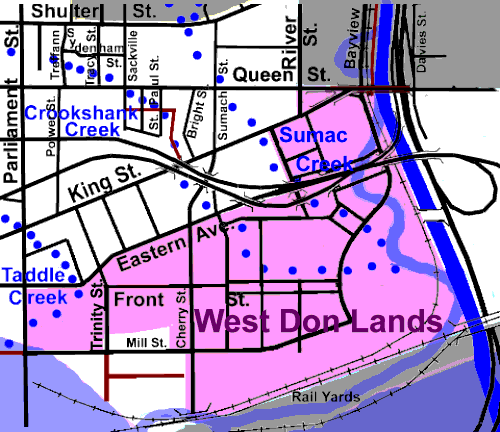Return to Don Channel Reach main page.
The neighbourhood of Corktown, south of Regent Park, now incorporates part of the southern reaches of “old” Cabbagetown. Along with a small number of houses east of River Street, this is the only part of the original Cabbagetown area that was not demolished in the 1940s. Corktown included the area to the south, shown in mauve on the map below. It is discussed on the West Don Lands Precinct page. This part of the City became known as Corktown because of the Irish immigrants, many of whom came from Cork in Ireland.
Click here to see sewers. Double click to remove.
To see Points of interest pass mouse over map.

In the mid nineteenth century, this easternmost part of the original City of Toronto extended to the Don River. The area was barely occupied but for some humble cottages, vegetable gardens and fields. In 1848, Enoch Turner funded the construction of a schoolhouse, on Trinity Street, the first free school in Toronto and the oldest schoolhouse still standing in the city. He wanted to provide basic education to the children of the many poor Irish immigrants in this part of the City.
This changed with the growth of industry and the advent of the railway in Toronto. In the late nineteenth century, much of the south end of old Corktown (now the West Don lands) was industrialized. The harbour, factory and rail complex, at the end of the Don River, provided jobs. This area became populated with urban workers. A residential neighbourhood developed. The residents were mainly poor, working class and lower middle class from the Anglo-Celtic immigration of the Victorian age. The majority of the population were English speaking, mostly Protestant, but with a significant Irish Roman Catholic minority. St. Paul’s Church, at Power and Queen, was the first Roman Catholic church in the city. Little Trinity Church at Trinity and King served the Protestants.
On Eastern Avenue just west of Cherry Street is the site of the Blackburn home. The Blackburns were slaves who escaped to Canada and started Toronto’s first taxi business. The Canary Restaurant is another interesting Cork Town sites in the West Don Lands.
Around the time of the Great War, residents began moving upward, and away from the area. Poorer people moved in to these houses. It was not unusual to have more than two families sharing a house. Morale grew increasingly lower, and the area became a slum. The houses were flimsily constructed, the landlords did little to keep up repairs. It was a place of hard work in adjacent factories, hardship, dirt and disease. It was, however, also a place of family and neighbourhood of bonding. In the late twentieth century the factories were abandoned and demolished, but poverty is still part of life here. This district is largely in the census area with the lowest household income in the city.
Tree cover is largely absent here except in the areas of old housing where there is a light tree cover that includes Manitoba, Norway & Silver Maples, Ash, Siberian Elm, Honey Locust & White Birch.
While originally this area drained to the Don River via Sumac, Crookshanks and Taddle Creeks, now most storm water goes to the Don via a storm sewer along Queen Street. Sanitary sewage flows to the Ashbridge’s STP via the Low Level Interceptor Sewer.
